

A change management checklist.
The 8-Step Process for Leading Change - Kotter International. Kotter International's videos. Formula for Change. The formula for change was created by David Gleicher while he was working at Arthur D.

Little in the early 1960s,[1] and refined by Kathie Dannemiller in the 1980s.[2] This formula provides a model to assess the relative strengths affecting the likely success of organisational change programs. Dannemiller version: D x V x F > R[edit] Three factors must be present for meaningful organizational change to take place.
These factors are: D = Dissatisfaction with how things are now; V = Vision of what is possible; F = First, concrete steps that can be taken towards the vision; Nature of Change. {To download a Word version, click here.}
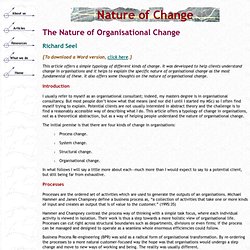
This article offers a simple typology of different kinds of change. It was developed to help clients understand change in organisations and it helps to explain the specific nature of organisational change as the most fundamental of these. It also offers some thoughts on the nature of organisational change. Introduction I usually refer to myself as an organisational consultant; indeed, my masters degree is in organisational consultancy. Stages of change. Kubler Ross change curve. Leadership through transition. Fundamental attribution error. In social psychology, fundamental attribution error (FAE), also known as correspondence bias or attribution effect, is the tendency for people to under-emphasize situational explanations for an individual's observed behavior while over-emphasizing dispositional and personality-based explanations for their behavior.
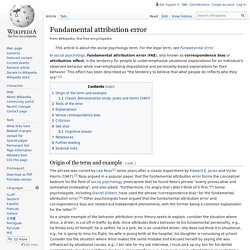
This effect has been described as "the tendency to believe that what people do reflects who they are".[1] Origin of the term and example[edit] As a simple example of the behavior attribution error theory seeks to explain, consider the situation where Alice, a driver, is cut off in traffic by Bob. Alice attributes Bob's behavior to his fundamental personality, e.g., he thinks only of himself, he is selfish, he is a jerk, he is an unskilled driver; she does not think it is situational, e.g., he is going to miss his flight, his wife is giving birth at the hospital, his daughter is convulsing at school. Classic demonstration study: Jones and Harris (1967)[edit] Explanations[edit] Change Management vs. Change Leadership. To Create Change, Leadership Is More Important Than Authority - Greg Satell.
By Greg Satell | 12:00 PM April 21, 2014 Aspiring junior executives dream of climbing the ladder to gain more authority.

Then they can make things happen and create the change that they believe in. Senior executives, on the other hand, are often frustrated by how little power they actually have. The problem is that, while authority can compel action, it does little to inspire belief. It’s not enough to get people to do what you want, they also have to want what you want — or any change is bound to be short lived. That’s why change management efforts commonly fail. In the 1850’s, Ignaz Semmelweis was the head physician at the obstetric ward of a small hospital in Pest, Hungary. In 2005, John Antioco was the eminently successful CEO of Blockbuster, the 800-pound gorilla of the video rental industry. Things ended poorly for both men. While today the insights of Semmelweis and Antioco seem obvious, they did not at the time. We tend to overestimate the power of influence. 5 Characteristics of a Change Agent. Cc licensed ( BY ) flickr photo shared by visualpanic (change agents) – People who act as catalysts for change… In my work through school and organization visits, I have been fascinated to see the correlation between the speed of change and an individual who is “leading” the charge.
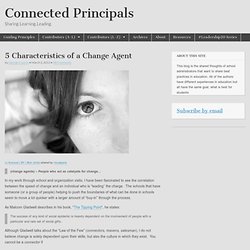
The schools that have someone (or a group of people) helping to push the boundaries of what can be done in schools seem to move a lot quicker with a larger amount of “buy-in” through the process. As Malcom Gladwell describes in his book, “The Tipping Point“, he states: Leading Change: Three Major Misconceptions That Hinder Innovation. These days almost every organization is discussing the need for innovation.

There is no CEO that talks with me about the company’s strategic drivers without mentioning ‘building more innovation power’. Every government is claiming innovation to be one of its key economic drivers. Innovation is hot. Managingchange. Leading Change through Polarity Management. Organizational Change Toolkit - Change Accelerator. Welcome to the Change Management Toolbook. Modern principles of organizational change management and employee training and development. Home » leadership/management » organizational change, training and learning modern principles of change management, and effective employee training and development in organizations Here are some modern principles for organizational change management and effective employee training and development.
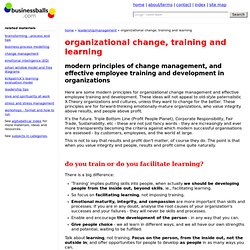
These ideas will not appeal to old-style paternalistic X-Theory organizations and cultures, unless they want to change for the better. These principles are for forward-thinking emotionally-mature organizations, who value integrity above results, and people above profit. It's the future. This is not to say that results and profit don't matter, of course they do. Do you train or do you facilitate learning? There is a big difference: 'Training' implies putting skills into people, when actually we should be developing people from the inside out, beyond skills, ie., facilitating learning. Talk about learning, not training. Change Management Course - Leading Change in Complex Organizations.
Janice A.

Klein currently teaches leadership in the Leaders for Manufacturing (LFM) and System and Design Management (SDM) Programs at MIT. Her recent research, summarized in True Change: How Outsiders on the Inside Get Things Done in Organizations (Jossey-Bass, 2004), explores knowledge transfer and the application of new ideas and concepts at the workplace. In addition, she leads a multidisciplinary research team investigating virtual collaboration and the development and maintenance of high-performance, globally dispersed teams. Klein’s earlier research focused on aligning operations and human resource strategies in the areas of job design, team leadership, employee empowerment, and organizational change.
Transformational Change. The ability to drive transformational change—such as moving from good to great performance, cutting costs, or turning around a crisis—is a key source of competitive advantage.
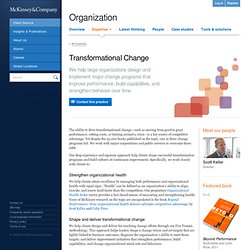
Yet despite the 25,000 books published on the topic, one in three change programs fail. We work with major corporations and public services to overcome these odds. Our deep experience and rigorous approach help clients shape successful transformation programs and build cultures of continuous improvement. Specifically, we work closely with clients to: Strengthen organizational health. Overview of Change Plan. Thought leader: The six stages of systemic change. Regular posted 19 Dec 2008 in Volume 12 Issue 4 By Jay Deragon A t first we don’t see the magnitude of changes resulting from all this ‘social stuff’.
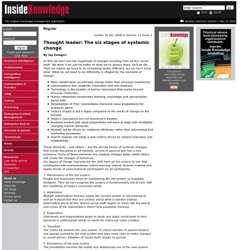
We think if we just do better at what we’ve always done, we’ll be OK. Then we realise we have to do something totally different, but we don’t know what. These elements – and others – are the driving forces of systemic changes that create disruption in all markets, society in general and fuel a new economy. 1. 2. The Vision Room The Pivot Point of Organizational Change - The Vision Room. We know that the vast majority of organizational change initiatives fail. Why? » Using Appreciative Visioning to Empower the Change Process. Home » Change Leadership The technique of appreciative inquiry (AI) can play an important role in the overall change management strategy.
AI challenges the status quo by working from a strength-based foundation. If you accept the following principles, AI may be a technique for change of interest to you: What you focus your energy on increasesEvery individual, team and organization has positive qualities to be discoveredPeople are receptive to being asked to share positive aspects of themselves through the process of telling storiesFocusing on the positive and working from strengths is more engaging to people than telling them they are a problem that needs to be fixedThrough telling our stories we can enhance the social systems we engage in daily and positively impact processes including communication, conflict resolution, decision-making, performance appraisals, and team interaction Recently, I interviewed Dr.
The wrong way to successful change. Why the low success rate? With your change initiatives, do you want a higher success rate? I’ve recently had several people express their wish for certainty that their change initiative will be successful the first time. A completely understandable and common desire. Change Management.